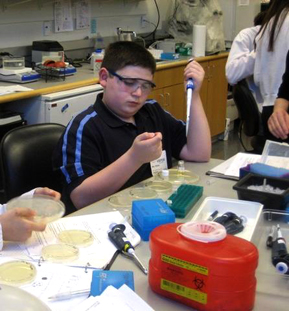The Inventive High School Sophomore
Max Wallack starts at BU Academy with some creative credentials

Think of incoming Boston University Academy 10th grader Max Wallack’s summer vacation as a variation on a theme: a couple of family trips, a little light reading, and some time with a favorite hobby.
The reading is David Foster Wallace’s Everything and More: A Compact History of Infinity, an optional book for one of Wallack’s academy courses this fall.
The hobby is taekwondo; Wallack holds what’s known as a recommended black belt.
The family’s August road trip to Toronto, however, also involved two days of Wallack being filmed for an Ontario TV show about promising young inventors.
It should come as no surprise that the summer activities of a 13-year-old inventor who first gained national recognition as a second grader, who counts among his accomplishments a project that helps people with Alzheimer’s disease and a cheap, easily built dome to house the homeless, are departures from traditional teenage pursuits.
In 2002, Wallack was accepted into the Nevada-based Davidson Institute for Talent Development’s young scholars program, which describes itself as dedicated to nurturing profoundly gifted young people.
At a Lake Tahoe event, institute founder Jan Davidson imparted an idea that helped Wallack set his course: those who have the ability to help others have the responsibility to do so.
“That phrase stuck with me,” Wallack says, sitting in his Natick home, sporting a T-shirt with an image of a gorilla from the Saint Louis Zoo. “So then I started inventing.”
In 2003, he won the top award in the Craftsman/National Science Teachers Association Young Inventors Awards Program for his Great-Granny Booster Step, a wooden step with a collapsible handle created to help his great-grandmother get in and out of the family minivan. He later invented the patent-pending Carpal Cushion.
Seeing that carpal tunnel syndrome was causing his maternal grandmother pain, he devised a cushion that is “basically cloth,” he says, “with two Velcro straps and Bubble Wrap inside so it’s kind of like the carpal tunnel is resting on air. It’s a soft way to relieve pressure.”
Another accomplishment he’s proud of is Puzzles to Remember, a project that distributes donated puzzles to places that care for people with Alzheimer’s.
Wallack, who wants to become a geriatric psychiatrist or biomedical engineer, came up with the idea in honor of his great-grandmother, who suffered from dementia before dying in her 90s. Working on puzzles helps slow the disease, he says. “I feel happy to help other people and to help people suffering from Alzheimer’s, because I know what it’s like to have someone who has Alzheimer’s. It’s really hard.”
Yet another creation, the Home Dome, has garnered the most attention.
When Wallack was in Chicago with his family to receive the award for his booster seat, they got lost in an area crowded with homeless people living in makeshift shelters (scenes from the Batman movie The Dark Knight were filmed there, he says).
“I always kept in the back of my mind how I might help these people,” he says.
When he found out about the Trash to Treasure Competition put together by the PBS show Design Squad, Intel, and the By Kids for Kids company, he designed the Home Dome, a dome made of panels of discarded Styrofoam peanuts stuffed into plastic bags and anchored by a built-in bed. He won the 2008 competition and a $10,000 check from Intel.
That’s what landed Wallack in Toronto for the TV filming and in Washington D.C., for a presentation before U.S. senators. But the attention hasn’t gone to his head, according to his mother, Linda Wallack.
“He wants to do what’s best for everybody, what’s best for himself,” she says.
Taekwondo helps, too. He took it up when he was four years old because he wanted a challenge. “I just thought that it would be kind of cool because I’m not that good at it,” he says.
His grandmother laughs. “If he starts thinking he’s good at anything, all he has to do is take another taekwondo class,” she says. “Ask him how many times he took the physical test before he passed it.”
His quick answer: four tries.
The self-described science and math person who also loves history will join about 50 new BU Academy students for orientation on September 1. Academy students use University resources and facilities daily, says Paige Brewster, director of admissions and financial aid. Starting junior year, they can take University courses; students who maintain at least a 3.0 grade point average in University-level courses are considered strong candidates for admission to most (though not all) undergraduate programs.
“We like to say we have the best of both worlds: our own high school that’s part of something much larger,” Brewster says.
Wallack is excited about small classes and “huge resources,” he says. Being part of something much larger shouldn’t be a big transition for a young inventor who already has been garnering national recognition. Perhaps his next invention will emerge as he walks along Comm Ave.
Comments & Discussion
Boston University moderates comments to facilitate an informed, substantive, civil conversation. Abusive, profane, self-promotional, misleading, incoherent or off-topic comments will be rejected. Moderators are staffed during regular business hours (EST) and can only accept comments written in English. Statistics or facts must include a citation or a link to the citation.